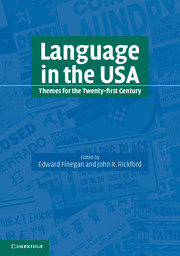Book contents
- Frontmatter
- Contents
- List of figures
- List of tables
- List of contributors
- Acknowledgments
- Foreword
- Editors' preface
- Part 1 American English
- Part 2 Other language varieties
- 7 Multilingualism and non-English mother tongues
- 8 Creole languages: forging new identities
- 9 Native American languages
- 10 Spanish in the Northeast
- 11 Spanish in the Southwest
- 12 American Sign Language
- 13 Asian American voices: language in the Asian American community
- 14 Linguistic diversity and English language acquisition
- Part 3 The sociolinguistic situation
- Index
10 - Spanish in the Northeast
Published online by Cambridge University Press: 05 June 2012
- Frontmatter
- Contents
- List of figures
- List of tables
- List of contributors
- Acknowledgments
- Foreword
- Editors' preface
- Part 1 American English
- Part 2 Other language varieties
- 7 Multilingualism and non-English mother tongues
- 8 Creole languages: forging new identities
- 9 Native American languages
- 10 Spanish in the Northeast
- 11 Spanish in the Southwest
- 12 American Sign Language
- 13 Asian American voices: language in the Asian American community
- 14 Linguistic diversity and English language acquisition
- Part 3 The sociolinguistic situation
- Index
Summary
Editors' introduction
Spanish has more speakers and more prominence in the USA than any language except English, and it is also the most popular “foreign” language studied in American secondary schools. This chapter describes Spanish in the Northeast – the character, origins, and speakers of Spanish in the New England states and New York, New Jersey, and Pennsylvania. The Spanish of the Northeast is spoken by immigrants and their children from the Caribbean and from Central America and South America, not chiefly by Mexican immigrants, as in the Southwestern USA. Ana Celia Zentella, herself the daughter of a Mexican father and a Puerto Rican mother, has studied Spanish speakers in New York City and elsewhere.
With fascinating detail, this chapter describes the patterns that characterize immigration into the Northeast from Spanish-speaking areas – Puerto Rico (long a protectorate of the USA and peopled by residents who are US citizens), the Dominican Republic, and South America's Colombia, to name some. This chapter documents the loss of Spanish language fluency in the children and grandchildren of these immigrants, striking notes that are also struck in other chapters that touch on the challenges of maintaining languages other than English in the USA (see especially chapters 7, 9, 11, 13, 14, and 17).
About the character of Spanish as it is spoken in the Northeast, the chapter provides documentation of its special features as influenced by the diverse origins of its speakers and its contact with English in spheres inside and outside the home and workplace.
- Type
- Chapter
- Information
- Language in the USAThemes for the Twenty-first Century, pp. 182 - 204Publisher: Cambridge University PressPrint publication year: 2004
- 13
- Cited by

